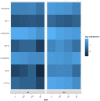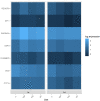Effect of Dietary Soy Protein Source on Effluent Water Quality and Growth Performance of Rainbow Trout Reared in a Serial Reuse Water System
- PMID: 37835695
- PMCID: PMC10571907
- DOI: 10.3390/ani13193090
Effect of Dietary Soy Protein Source on Effluent Water Quality and Growth Performance of Rainbow Trout Reared in a Serial Reuse Water System
Abstract
Juvenile rainbow trout (125 ± 0.8 g) were fed a fishmeal control diet (C), a high soy protein concentrate diet (SP), a high soybean meal diet (HiS), or a diet with high levels of fermented soy protein concentrate (fSP) for 12 weeks in a tank system capable of receiving 1st and 3rd use water from a serial-reuse production hatchery. Water quality was generally lower in 3rd use compared to 1st use water and after passing through tanks (inflow vs. outflow). Total dissolved solids were significantly higher (p = 0.003) for 3rd use compared to 1st use water, and values were also higher (p < 0.001) for the fSP diet. Turbidity and ammonia were highest in tanks for trout fed the HiS and fSP and SP and fSP diets, respectively, but were characterized by high variation, which likely prevented the detection of significant differences. Weight gain (p < 0.001) and survival (p = 0.008) were significantly lower for trout in 3rd use compared to 1st use water. Trout fed the HiS diet were generally in poorer physiological condition with lower body fat stores (p = 0.05) and lower growth rate (p < 0.001) and survival (p = 0.05) compared to the other diets, which were similar. The expression of several stress-associated genes (FK506, DIO2, REGPS, Cyp1a, G6PH, GADD45a, and IRF-1) in the liver and gill showed that diet and water source affected their regulation. Replacement of FM by SP providing 50% of dietary protein promotes acceptable growth performance compared to an FM diet and was superior to HiS. The impacts of soy protein concentrate on water quality under commercial production conditions, however, require further study.
Keywords: effluent; gene expression; raceway; rainbow trout; soy protein concentrate; soybean meal.
Conflict of interest statement
The authors declare no conflict of interest.
Figures








References
-
- Gatlin D.I., Barrows F., Brown P., Dabrowski K., Gaylord T., Hardy R. Expanding the utilization of sustainable plant products in aquafeeds: A review. Aquac. Res. 2007;38:551–579.
-
- Mateo-Sagasta J., Zadeh S.M., Turral H. FAO; Rome, Italy: 2018. More People, More Food, Worse Water? A Global Review of Water Pollution from Agriculture?
-
- Olsen R., Hasan M. A limited supply of fishmeal: Impact on future increases in global aquaculture production. Trends Food Sci. Technol. 2012;27:1120–1128.
-
- Ayadi F., Muthukumarappan K., Rosentrater K., Brown M. Twin-screw extrusion processing of rainbow trout (Oncorhynchus mykiss) feeds using various levels of corn-based distillers dried grains with solubles (DDGS) Cereal Chem. 2011;88:363–374.
-
- Francis G., Makkar H., Becker K. Antinutritional factors present in plant-derived alternate fish feed ingredients and their effects in fish. Aquaculture. 2001;199:197–227.
Grants and funding
LinkOut - more resources
Full Text Sources

